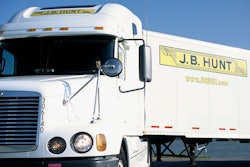 J.B. Hunt outlined several “best practices” for shippers that could significantly increase driver efficiency.
J.B. Hunt outlined several “best practices” for shippers that could significantly increase driver efficiency.J.B. Hunt (No. 6 on the CCJ Top 250) recently released a report directed at shippers and receivers on the full extent of the wasted time drivers spend as a result of their inefficient practices. Mitigating such inefficiencies, the report notes, can increase capacity.
And increase driver pay — as the end result is more drive time for operators.
The paper cites a BB&T study that says out of the 11 daily driving hours, or 660 minutes, allowed by the FMCSA’s Hours of Service regulations, only an average of 390 minutes are spent by drivers behind the wheel. Other time-consuming activities include empty driving time, time waiting on inflexible appointments and time spent at the shipper or receiver location for load and unload.
“A loss of minutes, even hours when compiled over many loads, can create a severe impact on capacity,” the paper states.
To counter this loss of productivity, J.B. Hunt offers several tips that could increase efficiency and capacity.
First, the company suggests eliminating 60 minutes per day from loading and unloading times. The study by BB&T found that drivers spent an average of 108 minutes at the shipper and receiver, not counting appointment time.
By eliminating just 30 minutes at the shipper and 30 minutes at the receiver, a single driver could remain on the road for an extra hour each day, equivalent to 50 miles per day, or 12,500 miles per year (assuming the driver spends 250 days on the road).

J.B. Hunt also suggests doing drop-and-hooks instead of live unloading. A study by the company found drivers spend 48 more minutes at a live unload than at a drop-and-hook. Losing those 48 minutes equates to 40 miles per day, or 10,000 miles per year if the driver is on the road 250 days a year.
J.B. Hunt also found that inflexible pickup and delivery times result in detention time and dwell time for drivers. The paper suggests shippers go to a 24/7 approach, as carriers have higher driver availability on nights and weekends, to help increase efficiency.
Another way drivers lose driving time is looking for a safe and legal parking spot before shutting down. The paper says to eliminate this problem, shippers could provide on-site parking and amenities.
If shippers and receivers utilized the “best practices” detailed in the paper, J.B. Hunt says more than 44,000 miles per driver on average could be gained each year.











